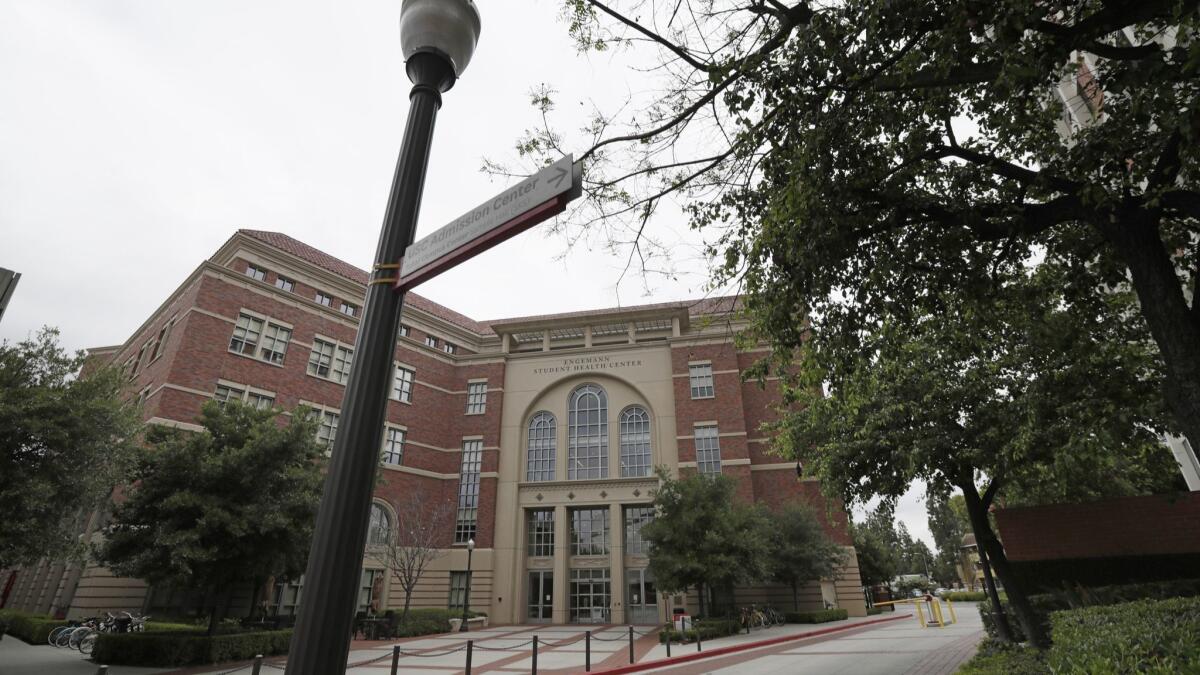Must Reads: A USC doctor was accused of bad behavior with young women for years. The university let him continue treating students
For nearly 30 years, the University of Southern California’s student health clinic had one full-time gynecologist: Dr. George Tyndall. Tall and garrulous, he treated tens of thousands of female students, many of them teenagers seeing a gynecologist for the first time.
Few who lay down on Tyndall’s exam table at the Engemann Student Health Center knew that he had been accused repeatedly of misconduct toward young patients.
The complaints began in the 1990s, when co-workers alleged he was improperly photographing students’ genitals. In the years that followed, patients and nursing staff accused him again and again of “creepy” behavior, including touching women inappropriately during pelvic exams and making sexually suggestive remarks about their bodies.
UPDATE: Former students recount decades of disturbing behavior by USC gynecologist »
In recent years, some colleagues feared that he was targeting the university’s growing population of Chinese students, who often had a limited understanding of the English language and American medical norms.
Still, Tyndall was allowed to continue practicing. It was not until 2016, when a frustrated nurse went to the campus rape crisis center, that he was suspended.
An internal USC investigation determined that Tyndall’s behavior during pelvic exams was outside the scope of current medical practice and amounted to sexual harassment of students. But in a secret deal last summer, top administrators allowed Tyndall to resign quietly with a financial payout.
The university did not inform Tyndall’s patients. Nor did USC report him at the time to the Medical Board of California, the agency responsible for protecting the public from problem doctors.
USC told The Times in a statement that it was under no legal obligation to report Tyndall. The statement said that “in hindsight,” USC should have reported him. The university said it belatedly filed a complaint with the medical board March 9 after a request by Tyndall to be reinstated. It was about a month after Times reporters began questioning university employees about Tyndall.
President C.L. Max Nikias sent a letter to the campus community Tuesday morning in advance of the publication of this story. Nikias noted that he had two daughters who attended USC and called Tyndall’s conduct “a profound breach of trust.”
“On behalf of the university, I sincerely apologize to any student who may have visited the student health center and did not receive the respectful care each individual deserves,” Nikias wrote.
In interviews with The Times, Tyndall, 71, insisted that he had done nothing wrong. He said he performed exams that were extremely thorough, but always appropriate.
“I’m there to protect the health of Trojan women,” Tyndall said.
This story is based on interviews with more than 20 current and former USC employees. Most spoke on the condition of anonymity, citing patient confidentiality laws and the potential of a negative effect on their careers. The Times also reviewed more than 100 pages of documents related to complaints against Tyndall and his response.
USC hired Tyndall in 1989 after his residency at Kaiser Permanente on Sunset Boulevard. He told people he had selected the job over higher paying opportunities to work with the bright, sophisticated women of what he often called “the Stanford of the South.” Even the license plate on his Acura declared his dedication to the job: It read COEDDOC, according to DMV records.
In the exam room, he was accompanied by a female nurse or medical assistant known as a chaperone — a practice embraced by many male gynecologists. In the years after he started, some chaperones became alarmed about the frequency with which he used a camera during pelvic exams, according to Tyndall and three colleagues with firsthand knowledge of the concerns.
Gynecologists can have legitimate reasons to take pictures, including research, teaching and soliciting second opinions from colleagues. Tyndall’s chaperones in the 1990s questioned his motivations, the sources said. One chaperone recalled him taking multiple pictures of hundreds of patients’ genitals, while another said she witnessed 50 to 100 patients photographed.
Bernadette Kosterlitzky, a clinic nurse from 1992 to 2013, said that after a chaperone alerted administrators to the camera, then-Executive Director Dr. Lawrence Neinstein ordered it removed.
“It was stopped as soon as it came to light,” said Kosterlitzky, who ran the clinic’s oversight committee.
Neinstein died in 2016.
Tyndall said he photographed patients’ cervixes and external genitals only with their permission and for valid reasons. In some cases, he said, he wanted to allay students’ fears that they had genital warts. In others, he wanted to document cervical exams in case a patient later filed a lawsuit accusing him of missing a cancer diagnosis.
He said the images were magnified and not sexual, but acknowledged chaperones were suspicious.
“It seemed to be causing too much controversy so I sent [the camera] to storage,” he said.
Students also spoke up. In the early 2000s, at least three patients submitted letters complaining about inappropriate touching and remarks, according to a member of the clinic oversight committee who spoke on the condition of anonymity. The letters, the source said, were read aloud during monthly committee meetings.
After the third time that an “alarming” letter about Tyndall was read aloud, the committee member said, he confronted Neinstein.
“I said, ‘Larry, this is unusual to get so many of these letters. Something needs to be done,’” he recalled. The source provided university records that corroborate his account.
Tyndall said he was never told of the complaints. It’s unclear what action Neinstein took, if any. USC said last week it had no information about the committee letters and that the deceased executive director had “handled patient complaints independently.”
An overdose, a young companion, drug-fueled parties: The secret life of a USC med school dean »
USC disclosed Tuesday that a recent review of Neinstein’s files found eight complaints against the gynecologist from 2000 to 2014. Some concerned “racially insensitive” remarks. Tyndall was accused at various times in his tenure of making insulting comments about African Americans and Latinos. Tyndall could not be reached to respond to these allegations.
Other reports in Neinstein’s file were about Tyndall’s patient care.
“Several of the complaints were concerning enough that it is not clear today why the former health center director permitted Tyndall to remain in his position,” the university said in a summary of the investigation into the physician.

Five years ago, the clinic moved into a brand-new building, named for a university trustee and her husband. But in the Engemann Student Health Center, the troubling questions about Tyndall only intensified.
Within months of the grand opening, chaperones observed behavior in the exam room that unsettled them, according to interviews with current and former employees as well as internal communications and notes reviewed by The Times.
Chaperones were concerned about what Tyndall described as a full body scan for unusual moles. They said Tyndall frequently had women lie naked on the exam table while he slowly inspected every part of their body, down to the area between their buttocks.
While he worked, he made comments that the nursing staff found unseemly. He described patients’ skin as “flawless,” “creamy” or “beautiful,” according to multiple people who witnessed the exams or were told about them. They said he remarked on students’ “perky breasts.”
“They stand right up there, don’t they?” one recalled him telling a patient.
Multiple witnesses to the exams told The Times that many patients were silent and did not complain.
“Some of them had never had a gynecological exam before,” said one longtime chaperone. She and other clinic staffers said his behavior was often trained on international students from Asia.
“They are so innocent, a lot of them. And they are going to do what you say,” the chaperone said.
In a memo to The Times, Tyndall said the body scans were to look for skin cancer and other conditions that warranted referral to a dermatologist. In interviews, he said a patient once asked him if her breasts were “perky,” and he used the word only in response to her query. Some of the other comments reported by the chaperones were misinterpreted, he said.
Multiple experts said a woman’s annual gynecological visit could include a discussion of skin problems, but said meticulous inspections of a patient’s nude body would be highly unusual if not inappropriate. They also said a physician should confine his comments to medical observations.
“You are looking for moles, not the individual impressions of the attractiveness of body parts,” said Frank W. Ling, the former president of the American Board of Obstetrics and Gynecology and co-author of a medical school textbook on the field.
In the spring of 2013, eight chaperones reported concerns about Tyndall to their supervisor, veteran nurse Cindy Gilbert. She went to Neinstein, the clinic’s executive director, and the head of clinic nursing, Tammie Akiyoshi. Gilbert said Neinstein told her that he had talked to Tyndall about his behavior in the past.
Akiyoshi, now the clinic’s executive director, did not respond to interview requests.
Neinstein referred the complaints to the university’s Office of Equity and Diversity, which investigates sexual misconduct and racial and gender discrimination. An investigator interviewed seven employees and a patient, according to USC. Tyndall, Gilbert and multiple chaperones who complained said they were never informed of the probe or questioned by the investigator.
Gretchen Dahlinger Means, the current executive director of OED, said none of those interviewed accused Tyndall of inappropriate touching or mentioned body scans or comments about breasts. She said one patient described him as “creepy” and a staff member recalled overhearing him tell a patient, “You are pretty enough to be a model.” Others, she said, had complimentary things to say about him.
The investigation concluded there was no violation of school policy.
“There was no there there,” Means said.
Neinstein informed Tyndall in the fall of 2013 that Gilbert had complained about him. In an interview, he said he felt blindsided and upset by what he viewed as false allegations. The only action Neinstein took as a result of the investigation was barring the gynecologist from locking the door of his office when with patients, according to Tyndall, Gilbert and others who worked with them.
Rattled by the accusations, Tyndall said he concluded his bosses didn’t understand how much students liked him and launched a campaign to collect positive feedback. As some students left their appointments, he handed them a letter.
“You indicated that you were very happy with the women’s health care that you received today...,” read a copy obtained by The Times. “Engemann’s managers greatly enjoy receiving favorable comments about Engemann and its clinicians.”
The letter provided the email addresses of clinic administrators and suggested patients blind copy Tyndall on any messages.
In interviews, Tyndall said he and his supervisors received scores of glowing emails from students. He provided copies of some letters to The Times with the author’s names redacted.
A student in USC’s public policy program wrote in 2014 that she had seen four gynecologists before Tyndall, and he was the first not to cause her pain.
“He explained exactly what he wants to do during the examination and how he does it,” she wrote.
A first-year student in 2014 said she was nervous about her appointment — the first made without her parents’ help. Tyndall, she wrote, made her feel “extremely informed and well cared for.”
Many patients pleased with their visits were Chinese nationals, Tyndall said. USC has aggressively wooed international students in recent years. The largest contingent is from China with about 5,400 students enrolled in 2017.
During consultations in his office, Tyndall tried to connect with these students, he said. He ordered a map of China and encouraged women to point out their home province. He kept a bamboo plant, the traditional Chinese symbol of longevity and vitality, on a shelf above his desk, and recalled how some patients liked to take pictures of it. He sometimes showed off a photo of his Filipina wife and shared details of their relationship, according to two former patients.
“The word got out. A lot of [Chinese] patients would say, ‘My friend recommended you,’” Tyndall said in an interview.
As he courted these patients, Tyndall’s co-workers were becoming increasingly disturbed by his behavior in the exam room. On top of the conduct they had already reported, chaperones began discussing the way Tyndall used his fingers during the pelvic exam for many young women.
In the final stage of the exam, gynecologists often assess the uterus for lumps and other abnormalities by inserting two fingers inside a patient while pressing on her lower abdomen.
What troubled chaperones was Tyndall’s use of his fingers at the start of the exam. Before inserting a speculum, the metal duck-billed device that spreads open the walls of the vagina and enables the doctor to view the cervix, he would voice concern that the speculum might not fit.
“He would put one finger in and say, ‘Oh, I think it will fit. Let’s put two fingers in,’” said a chaperone who worked with Tyndall for years. Four people familiar with Tyndall’s exams said that while he spoke, he was moving his fingers in and out of the patients.
They said he made nearly identical statements to hundreds of women as he probed them: My, what a tight muscle you have. You must be a runner.
The chaperone who worked with Tyndall for years said she witnessed at least 70 such exams and remembered thinking the physician would eventually become embarrassed about repeating the same words to student after student.
“He never was,” she said.
During some exams, Tyndall made explicit reference to sexual intercourse while his fingers were inside patients, according to five people who heard the remarks or were told about them.
“He would tell young ladies their hymens are intact. ‘Don’t worry about it, your boyfriend’s gonna love it,’” a chaperone recalled.
In interviews, Tyndall defended his routine use of fingers at the start of the pelvic exam, saying it served legitimate medical purposes. He said the method enabled him to identify women with vaginismus, a condition in which vaginal muscles involuntarily spasm, making pelvic exams particularly painful. Tyndall also said he sought to assess the health of pelvic floor muscles.
“The medical assistants know patients are smiling and that I never cause pain,” he said.
Dr. Sangeeta Mahajan, a national expert in pelvic pain, said she had never heard of a gynecologist moving his fingers in and out of a patient to gauge whether a speculum would fit and called the practice “very odd” and “creepy.”
Mahajan, the chief of Female Pelvic Medicine and Reconstructive Surgery at University Hospitals Cleveland Medical Center, said inserting fingers before the speculum was not “a reliable” way of identifying vaginismus.
Dr. Louise King, an assistant professor of gynecology at Harvard Medical School, said she found Tyndall’s explanation not standard. She said that pelvic floor muscles do not typically pose problems for young women and are not examined unless a patient reports pain there.
“It wouldn’t be something a general gynecologist would do by rote,” King said.
At Engemann’s first-floor walk-in clinic, a nurse said that she spoke to at least five women in 2013 and 2014 who refused to be scheduled with Tyndall despite having gynecological problems that needed immediate attention.
Some said “they felt like he was inappropriately touching them, that it didn’t feel like a normal exam,” the nurse said. “They felt like they were violated.”
She told her immediate supervisor and later Akiyoshi, the head of nursing, who said “they would look into it,” she recalled.

One clinician who recounted unsolicited complaints from at least three students from 2013 to 2016 said, “Patients complained they would never see him again.”
The clinician gave the students the email address for Neinstein or another administrator and encouraged them to put their complaints in writing. It is unclear if they did.
A Chinese graduate student who saw Tyndall in 2016 told The Times she found it unprofessional when he pointed out a picture of his wife during their initial consultation. The student, who spoke on the condition of anonymity, said she decided to go forward with an exam that day after looking at the diplomas on his wall and reminding herself, “He’s a real doctor.”
He placed his fingers inside her at the start of the exam, saying he was determining if the speculum would fit. She said she tried not to “overthink” what was happening. Of the visit with Tyndall, she said, “I was not comfortable, but that was the only choice I had.”
When she returned for test results another day, a nurse told her that Tyndall wanted her to remove all her clothes for an exam, she said. As she waited for him naked, she began to have doubts.
“It’s not right. Why do I have to take off all my clothes?” she recalled thinking. She dressed and told a female clinic employee she wanted to see another doctor.
“She said there were a lot of complaints” about Tyndall, the student recalled.
Told of the woman’s account of being asked to disrobe for test results, Tyndall said: “No. Impossible. Never happened.” He speculated he was being “set up” by clinic staff.
Another student, an undergraduate from the Middle East, said that when she went to get a prescription for birth control, Tyndall appeared fixated on her heritage and virginity. She told him she wasn’t religious, but he was not deterred, said the student, who spoke on the condition of anonymity.
“He offered me a little baggie of blood I could pop on my wedding night so my husband would think I was a virgin,” she said. “I was weirded out, but I was in a rush to get birth control.”
She said Tyndall’s pelvic exam was brief and she did not recall if he used his fingers before the speculum. While her friends got yearlong birth control prescriptions from other clinics, Tyndall approved only a two-month supply, she said.
On a return visit to renew the prescription, he posed questions about her first sexual experience in a way she found prurient.
“He asked how many times we’d tried and if it hurt because I was tight,” she said.
He continued providing her short-term prescriptions that required her to revisit the clinic. On one occasion in 2016, she wept when a clinic staffer tried to take her blood pressure.
“I told her I was feeling pressured … and just wanted my prescription,” she said.
The nurse who took down her complaint said she was not the first, the student said.
Tyndall called the woman’s account “so bizarre” and denied making the comments she alleged.
Chaperones gave their supervisor, Gilbert, the names of women who seemed particularly shaken by Tyndall’s exams. Gilbert said she contacted patients and explained how to make a written complaint against the doctor. Some did, but others indicated they just wanted to find another gynecologist and forget about the experience, she said.
Gilbert volunteered to assist Tyndall to see his exams firsthand and said she witnessed at least a dozen pelvic exams she felt were inappropriate. In one case, she said, Tyndall removed an intrauterine device from a patient and then asked the young woman if he could keep the used birth-control device, which was covered in blood and tissue.
“The girl just looked so confused,” Gilbert said.
Multiple experts said they had never heard of such a request and knew of no medical reason a doctor would retain an IUD.
Tyndall did not respond to questions about the IUD.
Chaperones forwarded some complaints about Tyndall to Sandra Villafan, who had replaced Kosterlitzky in 2013 as the clinic’s head of quality and safety. In response to queries from The Times about Tyndall, Villafan said she had relayed “any student and staff concerns” to clinic administrators and university leadership.
“Interviews and investigations were conducted in a timely manner but I was not privy to the conclusions or details of them,” Villafan, now at Stanford University’s student health center, wrote in an email.
Gilbert said she went to Akiyoshi, Neinstein and other clinic administrators repeatedly from 2014 to 2016. They seemed uninterested, she said.
Tyndall continued seeing patients — as many as 16 a day. The frustration among chaperones was profound. Gilbert recalled one longtime medical assistant at the clinic emerging from Tyndall’s exam room in tears.

“She felt so strongly that it was wrong and that it could easily be any of our daughters,” Gilbert said.
Another chaperone said: “A chorus of people were saying there’s something inappropriate about this guy.”
Increasingly, Gilbert said, she struggled with the feeling that she was letting down everyone around her — patients, chaperones and the university itself.
“It became clear he wasn’t going to stop,” Gilbert said. “Some things you can ignore. Some things you can’t.”
In June 2016, Gilbert went to USC’s rape crisis center, known as Relationship and Sexual Violence Prevention and Services, and spoke to Executive Director Ekta Kumar.
“We all feel the same. We can’t get anyone to act on it,” Gilbert recalled telling Kumar.
She said Kumar, a psychologist, seemed astonished and used the word “abuse” in response to her description of Tyndall’s conduct. She said Kumar promised to take the matter higher at USC.
Kumar, who left the university last year, declined to comment, saying all her work at USC was confidential.
A few days later, Gilbert and other staffers noticed a swarm of tiny flies on the second floor of the clinic, multiple employees said. Eventually they traced the infestation to Room 215 — Tyndall’s office.
The gynecologist was on vacation so Gilbert and other employees unlocked his door to look for the source of the insects. They eventually located a sack of rotten fruit under Tyndall’s desk. While searching, they stumbled upon a box in a cabinet containing images of patients’ genitals.
The slides and photographs were shot in the old clinic in 1990 and 1991 and some were labeled with identifying patient information, according to Tyndall and others who saw the photos or were told about them. A senior clinic administrator confiscated the box.
In the wake of Gilbert’s report to the rape crisis center and the discovery of the images, university officials moved rapidly.
A human resources staffer phoned Tyndall on a Sunday and told him not to return to the clinic. He continued to receive his salary, but was banned from campus. In subsequent meetings, USC lawyers told him they had launched two investigations — one into the photos and another into the complaints of students and staff. Lawyers for USC interviewed Tyndall on several occasions and he steadfastly defended his practices. Chaperones were just as adamant in criticizing his medical treatment in their interviews with investigators.
One chaperone was asked how she would react if Tyndall returned to the clinic. The woman said she was prepared to go to the police, according to three people with knowledge of the conversation.
USC said in the summary it released Tuesday that at some point in the investigation school officials consulted “a gynecology expert who stated” that Tyndall’s use of fingers in pelvic exams “could be considered an acceptable practice.” The school said it did not have consent to disclose the identity of the expert.
Ultimately USC brought in a Colorado-based consulting firm, MDReview, and a gynecologist from Kansas to interview Engemann staff and Tyndall. The firm found that Tyndall had “exhibited unprofessional and inappropriate behavior” and that his pelvic exams were outside “current standards of care,” USC said in a statement.
Laura LaCorte, the university’s compliance chief, said in an interview that her review of the photos found no federal or state privacy violations. Most images lacked identifiable patient information, but a small collection “were labeled with names that were not possible to accurately trace,” the university said. LaCorte said the images were “purely clinical” and “there was nothing sexual about them.”
The university consulted with two criminal attorneys about whether Tyndall’s pelvic exams constituted a crime, but both lawyers determined there was no criminal activity to report, school officials said.
“We did not have a ‘victim’ to talk to about what had occurred,” said Means, the OED director and a former sex crimes prosecutor.
Administrators sent a patient survey to 2,500 students — male and female — treated at Engemann in the spring of 2016. A quarter of the recipients were patients of Tyndall. The university declined to provide a copy of the questions to The Times.
USC said it received less than two dozen responses and “of those, only two provided negative feedback” about Tyndall and both were “unrelated to the conduct of his gynecological exams.”
In January 2017, Tyndall was called to a conference room in a building on the edge of campus and presented with a four-page letter informing him that he had violated university policy on sexual harassment.
The letter included MDReview’s findings about his pelvic exams.
“I was shocked,” he recalled. He vowed to appeal and pressed university officials to let him access his office where he had documents.
Then in May, Ainsley Carry, the vice president of student affairs, summoned Tyndall to a meeting, he said. A powerful figure at USC, Carry presided over Greek life, student government, the rape crisis center and student health. He reported directly to Provost Michael Quick.
Carry told Tyndall he was slated for termination. What happened next is in dispute.

Tyndall said Carry proposed an alternative to firing. If Tyndall agreed to resign, he would be given a severance and the conclusion of the investigation would be changed to “no finding,” the physician recalled Carry saying.
Tyndall said he inquired what would happen if he refused the deal.
“I asked, ‘Are you going to report that to the medical board?’ And he said, ‘Probably,’” Tyndall recalled.
Carry called Tyndall’s account of the conversation “false” in a statement through a USC spokeswoman.
“USC would never offer to change OED findings. Those findings stand today and remain in his file,” Carry said.
The university said Tyndall threatened to sue USC for age and gender discrimination and “rather than engage in protracted litigation” they sought a settlement.
Tyndall said he initially refused Carry’s settlement offer and remained committed to appealing. But USC continued to urge him to take the deal, he said. The university’s deputy general counsel, Stacy Rummel Bratcher, met with him and Carry twice that spring. At the second meeting, Tyndall said, they handed him a separation agreement and said he had 21 days to sign or face termination.
Tyndall said he had done nothing wrong, but felt like he had no choice. He signed the document minutes before the deadline, he said. The terms prevented him from disclosing the amount USC paid him. It also barred him from returning to the clinic, he said.
Bratcher declined to comment through a USC spokeswoman.
Tyndall’s resignation was effective June 30, 2017. Clinic staffers were not told. A few weeks later, they watched as his belongings were removed from his office. A terse email in October informed colleagues only that Tyndall was “no longer with the University of Southern California.”
State law requires hospitals and many clinics to notify the medical board in a variety of circumstances where they suspend, discipline or terminate the privileges of physicians. These reports automatically trigger state investigations into a doctor’s license and hospital leaders face steep fines for failing to report.
USC said the law didn’t apply in Tyndall’s case because the university itself wasn’t governed by the rules for hospitals and clinics and the complaints against the gynecologist “were made as a human resources matter.” The university also said Tyndall had told school officials that he was going to retire from practice.
“In hindsight, while not legally obligated, USC now believes it should have filed a consumer complaint with the Medical Board earlier in 2017 when Tyndall resigned,” the university said in a statement.
USC said in a statement that it does not believe Tyndall should be allowed to treat patients and said the university is “re-evaluating its process” on reporting physicians. Last week, after The Times sent administrators detailed questions about Tyndall, school administrators contacted the Los Angeles County district attorney’s office and later the Los Angeles Police Department. The outcome of those conversations is not clear.
By the time Tyndall resigned, Gilbert had also left USC. She said she had been promised a promotion and even given business cards with the new title. But she said that in the wake of her report to the rape crisis center, administrators rescinded the promotion. Some clinic managers stopped talking to her, she said. She and many co-workers interpreted it as retaliation for speaking out about Tyndall. She resigned in June 2017.
USC disputed Gilbert’s account and denied retaliating against her.
In a series of interviews this spring, Tyndall portrayed himself as a victim. At one point, he offered a theory that chaperones reported him because they had trouble reaching orgasm and were jealous of young patients with tighter pelvic muscles.
After speaking for more than 10 hours, Tyndall cut off communication with The Times and said he was mulling over a lawsuit against USC that might force administrators to reinstate him at Engemann.
“When I am on my deathbed,” he said, “I want to think there are thousands and thousands of Trojan women out there whose health I made a difference in.”
Tyndall renewed his California medical license in January. He has said he intends to work well into his 80s.
harriet.ryan@latimes.com | Twitter: @latimesharriet
matt.hamilton@latimes.com | Twitter: @MattHjourno
paul.pringle@latimes.com | Twitter: @PringleLATimes
More to Read
Sign up for Essential California
The most important California stories and recommendations in your inbox every morning.
You may occasionally receive promotional content from the Los Angeles Times.












